Tips To Grow And Care For Coffee Plants

This post may contain affiliate links. If you make a purchase through links on our site, we may earn a commission.
Coffee plants are usually cultivated industrially to meet the ever-growing demand for coffee beans. However, only a few individuals realize that this caffeine-induced plant can also be grown as an awesome houseplant.
This plant is among the easier plants to cultivate as a houseplant and in your backyard garden. With the right care, as discussed below, these plants can survive in diverse conditions.
Coffee Plant Overview
| Scientific Name | Coffea spp. |
| Common Name | Coffee Plant |
| Family | Rubiaceae |
| Type | Evergreen Shrub |
| Size | 3-8 feet in height |
| Sunlight Requirement | Partial to full sunlight |
| Soil Type/pH | Well-draining, slightly acidic to neutral soil (pH 6-6.5) |
| Growing Season | Year-round, with a rest period after flowering |
| USDA Growing Zone | 10-11 |
| Native Area | Tropical regions of Africa, Asia, and South America |
What Is A Coffee Plant?
The coffee plant, scientifically known as Coffea, is a captivating evergreen shrub renowned for its economic and sensory significance. Typically cultivated for its beans, it exhibits glossy, dark-green leaves with a waxy texture. The plant's appearance can vary, with robusta and arabica being the main species.
Coffee plants can be both indoor and outdoor companions, thriving in well-drained soil with adequate sunlight. Apart from its agricultural prominence, the coffee plant holds cultural and religious significance in various societies. It has become a symbol of social interaction, fostering connections and rituals worldwide.
From coffee ceremonies in Ethiopia to the reverence of coffee in spiritual practices, this plant weaves itself into the fabric of human culture, offering not just a beverage but a shared experience and a source of inspiration.
Coffee Plant Care
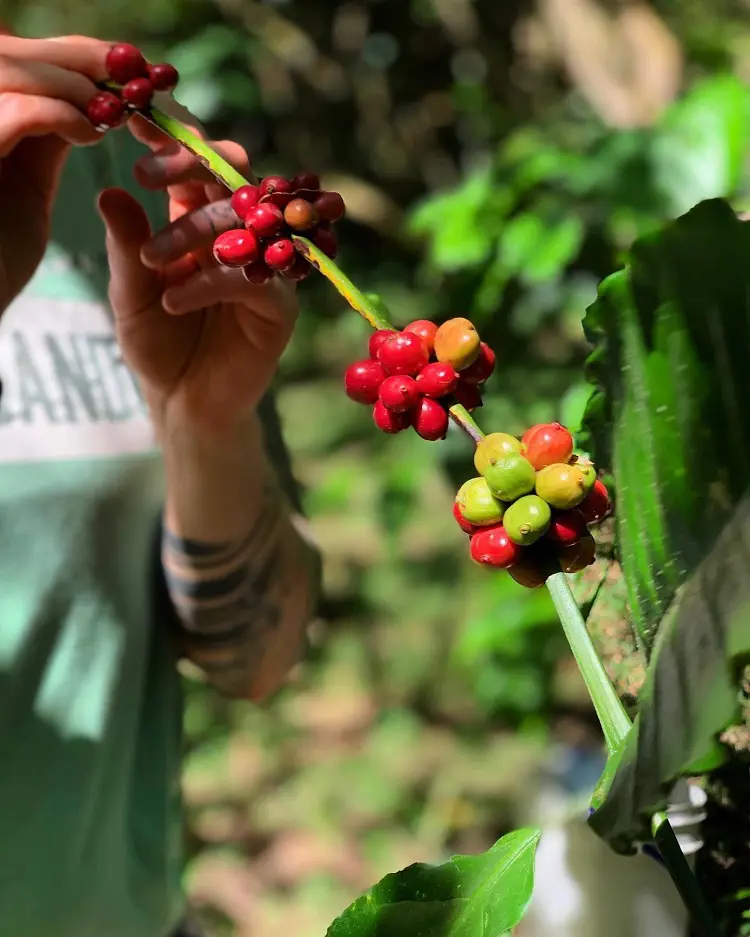
Caring for coffee plants is essential. Without proper attention, they may succumb to pests, diseases, or nutrient deficiencies, leading to stunted growth and poor coffee bean development. Inadequate watering, sunlight, or pruning can compromise plant health.
Regular care ensures optimal growth, and higher yield, and guards against potential issues that might hinder the plant's overall well-being.
Light
Coffee plants flourish in bright, indirect light, making them ideal for locations with filtered sunlight. While they can withstand some direct sunlight, protecting them from intense rays prevents leaf scorching.
For indoor cultivation, positioning coffee plants where they receive morning sun and afternoon shade replicates their native environment. This balance fosters optimal growth, ensuring that the plants receive sufficient light without the risk of sun damage.
Soil
Opt for well-draining, acidic soil with a pH ranging from 6 to 6.5. A blend of peat moss, perlite, and organic matter ensures a nutrient-rich growing medium. This combination promotes optimal root health and growth. Adequate drainage is essential to prevent waterlogging, safeguarding the roots from potential rot.
By providing the right soil conditions, you set the foundation for a thriving coffee plant, supporting its nutrient uptake and overall well-being.
Water
Keep the soil consistently moist, avoiding waterlogging to prevent root issues. Water when the top inch of soil feels dry, adjusting frequency according to environmental factors and the plant's developmental stage. During the winter dormant phase, reduce watering to accommodate the plant's decreased metabolic activity. This balanced approach to watering fosters optimal hydration, supporting the coffee plant's growth cycles while preventing both underwatering stress and the risks associated with excess moisture.
Temperature
Aim for temperatures between 60-70°F (15-24°C), ensuring a climate that mimics their native habitat. While they can endure short periods of cooler temperatures, safeguard them from frost. Indoors, provide a stable temperature environment, shielding the plants from drafts.
Humidity
Maintaining moderate to high humidity is essential for the well-being of coffee plants. Regular misting or employing a humidifier is recommended in dry conditions to prevent leaf desiccation. Grouping plants can naturally create a microenvironment with elevated humidity, benefiting the coffee plant.
Adequate humidity supports the plant's overall health. It provides proper moisture levels for leaf function and fosters an environment that mirrors the humid climates where coffee plants naturally flourish.
Fertilization
During the growing season (spring to early autumn), use a balanced liquid fertilizer every 2-4 weeks. In winter, reduce or stop fertilization. Organic, slow-release fertilizers can also be applied.
Ensure the fertilizer contains essential nutrients like nitrogen, phosphorus, and potassium for healthy growth and bean development. Adjust fertilizer amounts based on the plant's size and health.
Pruning Coffee Plant
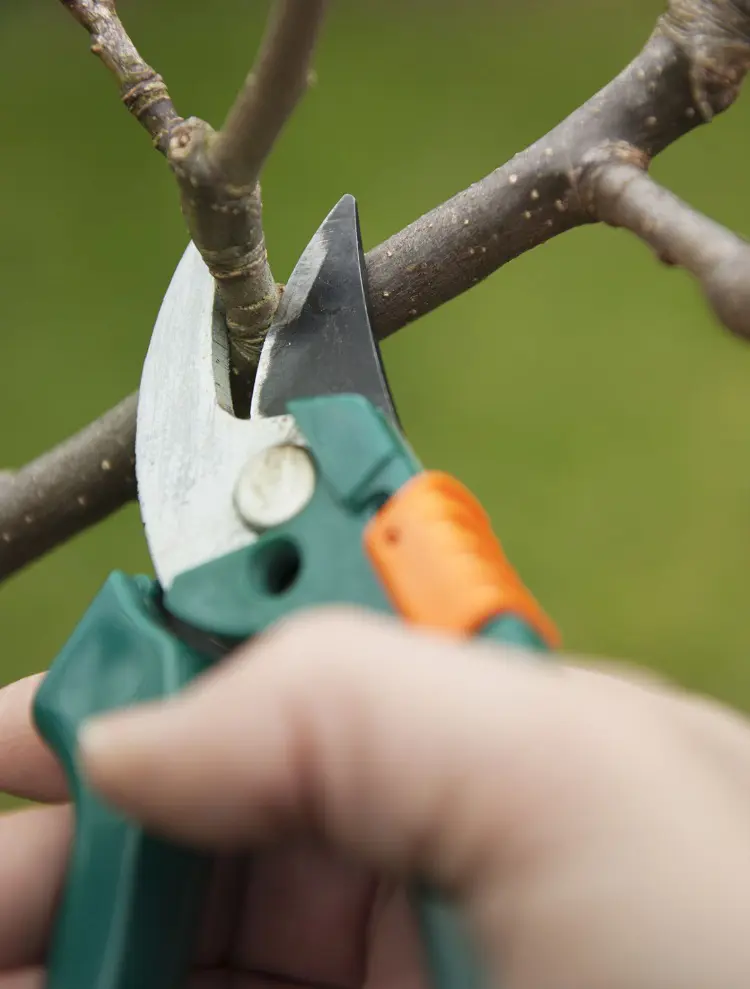
Pruning a coffee plant is essential for increased yield, disease prevention, and aesthetic maintenance. Ignoring pruning results in reduced productivity as the plant expends energy on unnecessary growth.
Over time, it becomes leggy, susceptible to diseases, and challenging to manage, impacting both the health and appearance of the coffee plant. Here's a guide on how to prune a coffee plant and its benefits:
How to Prune
- Remove Dead or Diseased Branches: Begin by cutting off any dead or diseased branches. This helps prevent the spread of diseases and ensures the plant focuses its energy on healthy growth.
- Shape the Plant: Trim the plant to maintain a desirable shape. Coffee plants naturally grow with a central stem; you can encourage a bushier appearance by cutting back the top growth, promoting lateral branching.
- Control Height: If growing indoors, prune to control the height. This encourages a more compact and manageable size. Trim the top growth to encourage lateral branching, giving the plant a fuller appearance.
- Harvesting Pruning: After harvesting coffee beans, prune to remove any older, unproductive branches. This stimulates new growth and ensures a continuous supply of fresh beans.
Benefits of Pruning
- Encourages the development of new growth, leading to increased flower and fruit production. This results in a higher yield of coffee beans.
- Removes excess foliage and allows for better air circulation within the plant. Pruning also reduces the risk of fungal diseases and promotes overall plant health.
- Pruning helps maintain a pleasing and manageable shape for indoor or outdoor cultivation. It prevents the plant from becoming leggy and enhances its visual appeal.
- By removing dead or unnecessary branches, the plant can redirect its energy towards healthy growth and the production of coffee cherries.
Propagation Techniques
Coffee plants can be relatively easily propagated through methods like seeds, cuttings, air layering, and division. While germination from seeds may take time, other methods, such as cuttings and air layering, offer quicker results. Propagation allows for genetic diversity, maintaining desirable traits, and expanding your coffee plant collection.
Here are common techniques:
- Seeds: Extract seeds from ripe coffee cherries, plant them in a well-draining, acidic soil mix, and keep them consistently moist. Germination may take several weeks.
- Cuttings: Use stem cuttings with at least two nodes. Root them in a mix of perlite and peat moss. Maintain high humidity until roots develop.
- Air Layering: Encourage roots on a branch while it is still attached to the parent plant. Once roots form, cut and transplant the rooted section.
- Division: Divide mature plants at the roots during repotting. Ensure each division has a healthy portion of roots and foliage.
How To Grow Coffee Plant From Seed
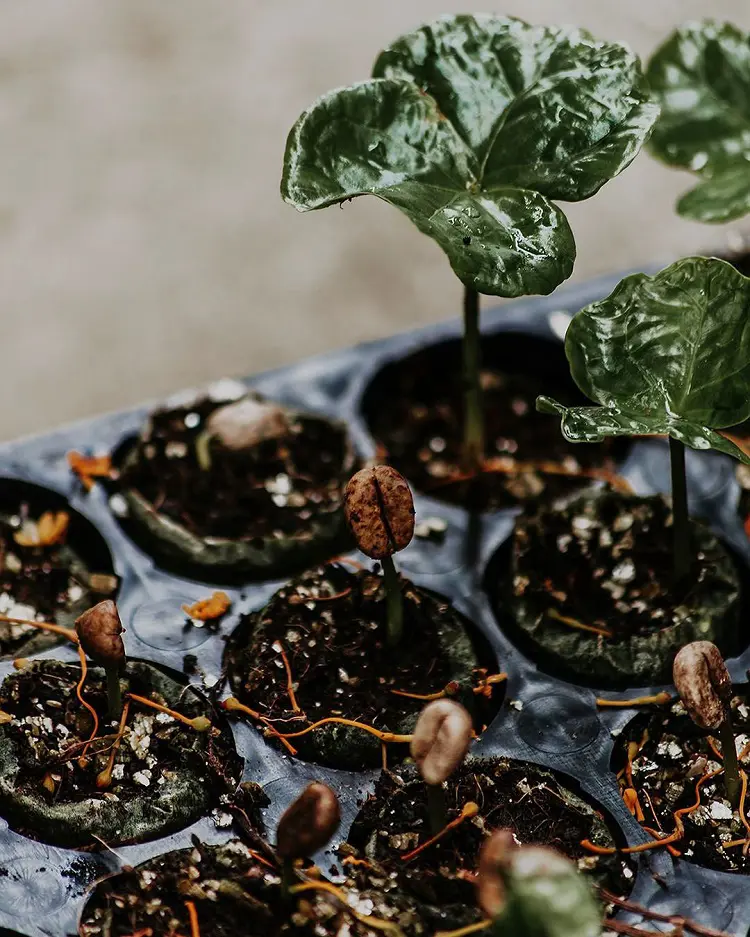
Growing a coffee plant from seed involves several steps. Follow this guide to learn how to do it:
1. Seed Collection: Obtain fresh, ripe coffee cherries. Extract the seeds, also known as coffee beans, from the pulp.
2. Seed Preparation: Remove the parchment-like covering around the seed. Wash seeds to eliminate any residual mucilage.
3. Seed Planting: Plant the seeds in a well-draining, acidic soil mix. Ensure the seeds are planted horizontally, not vertically.
4. Germination: Keep the soil consistently moist and maintain a warm, humid environment. Germination may take several weeks to a few months.
5. Transplanting: Once the seedlings have developed several leaves and are sturdy enough, transplant them into individual pots with a suitable growing medium.
6. Growing Conditions: Place the pots in a location with filtered sunlight. Coffee plants thrive in temperatures between 60-70°F (15-24°C).
7. Watering: Keep the soil consistently moist but not waterlogged. Allow the top inch of soil to dry out before watering.
8. Fertilization: Begin fertilizing when the seedlings are a few inches tall, using a balanced liquid fertilizer. Follow a regular fertilization schedule during the growing season.
Potting and Repotting
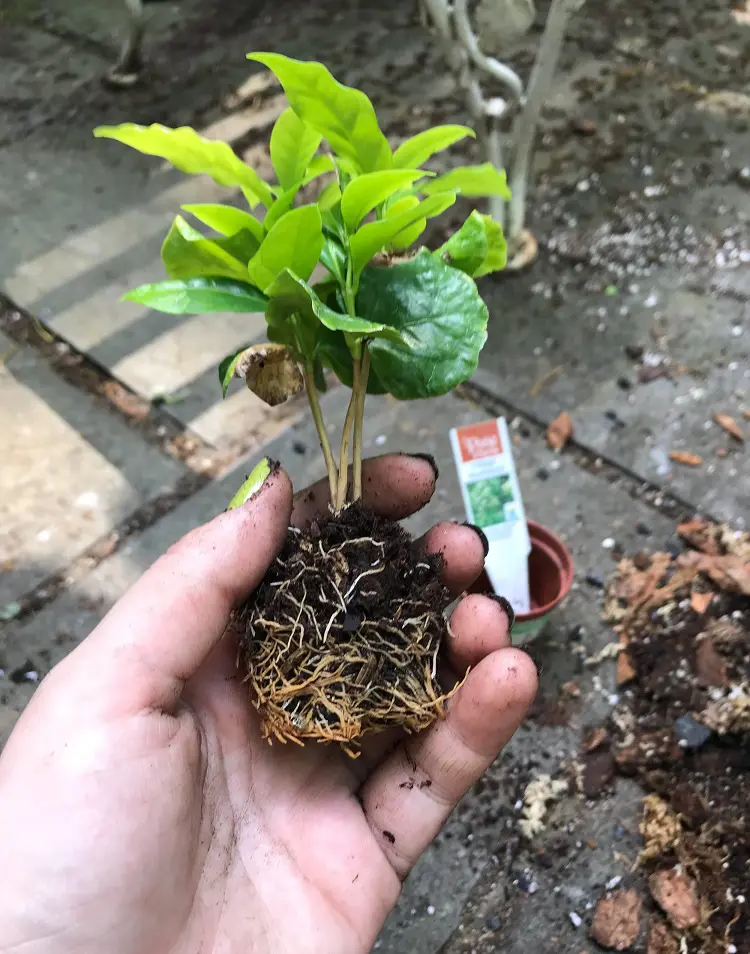
Potting and repotting a coffee plant are essential for its health and vitality. Initially, potting provides a suitable environment for root development along with proper drainage and nutrient availability. Repotting becomes necessary as the plant grows, preventing it from becoming root-bound, enhancing nutrient access, and promoting a more robust root system.
This periodic care supports overall plant health, encourages optimal growth, and prevents issues associated with overcrowded or depleted soil. Here's a general guide on how to pot and repot your coffee plant:
Potting
When potting a coffee plant, choose a slightly larger pot with drainage holes to prevent waterlogging. Use a well-draining mix of peat moss, perlite, and organic matter; maintain a slightly acidic pH around 6. Before repotting, hydrate the plant by watering it a few hours before.
Carefully extract the plant from its current pot, ensuring root preservation. Inspect roots for signs of rot or disease, trimming any damaged parts. Place the plant in the new pot at the same depth and fill with fresh potting mix. Thoroughly water the plant post-repotting to settle the soil and hydrate the roots effectively.
Repotting
For successful repotting of a coffee plant, choose the spring or early summer, aligning with its active growth phase. Repot when the plant shows signs of outgrowing its pot, becoming root-bound, or displaying health issues. Gently extract the plant from its current container, ensuring careful root handling.
Conduct root pruning by trimming circling or excessively long roots to promote a compact root system. Prioritize inspecting for pests, diseases, or stress indicators and address any problems before repotting.
Blooming Coffee Plant
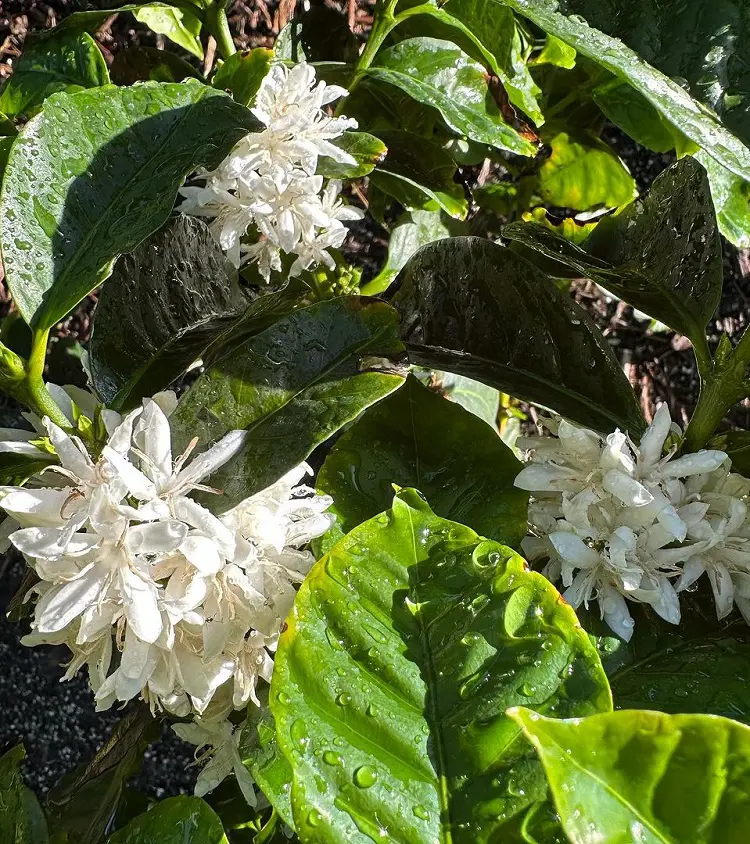
Coffee plants can bloom, and it's a crucial stage for coffee production. Blooming occurs when the plant is mature, typically 3-4 years old, and under specific conditions like the right temperature and light exposure.
The small, fragrant white flowers transform into coffee cherries. While indoor plants may bloom less frequently due to controlled conditions, outdoor plants experience more natural blooming. Adequate care, including proper fertilization and environmental conditions, encourages regular blooming, leading to the eventual harvest of coffee cherries.
When Does The Coffee Plant Bloom
The coffee plant typically blooms after three to four years of cultivation. The flowering period varies based on the coffee variety and environmental conditions. In general, flowering occurs once a year, lasting for several weeks.
The duration can be influenced by factors such as altitude, climate, and regional differences. Once the coffee plant blooms, it eventually develops small white flowers, marking the initial stage of coffee cherry formation, which later ripens to produce coffee beans.
Appearance and Fragrance While Blooming
During the blooming phase, the coffee plant showcases delicate, white, waxy flowers with a star-like appearance. These blossoms emit a subtle, sweet fragrance that is often compared to jasmine. The fragrance is most pronounced during the peak of the blooming period.
The visually striking and aromatic nature of the coffee plant's blossoms contributes to the overall allure of coffee cultivation, creating a sensory experience for those involved in the coffee production process.
Coffee Plant Types
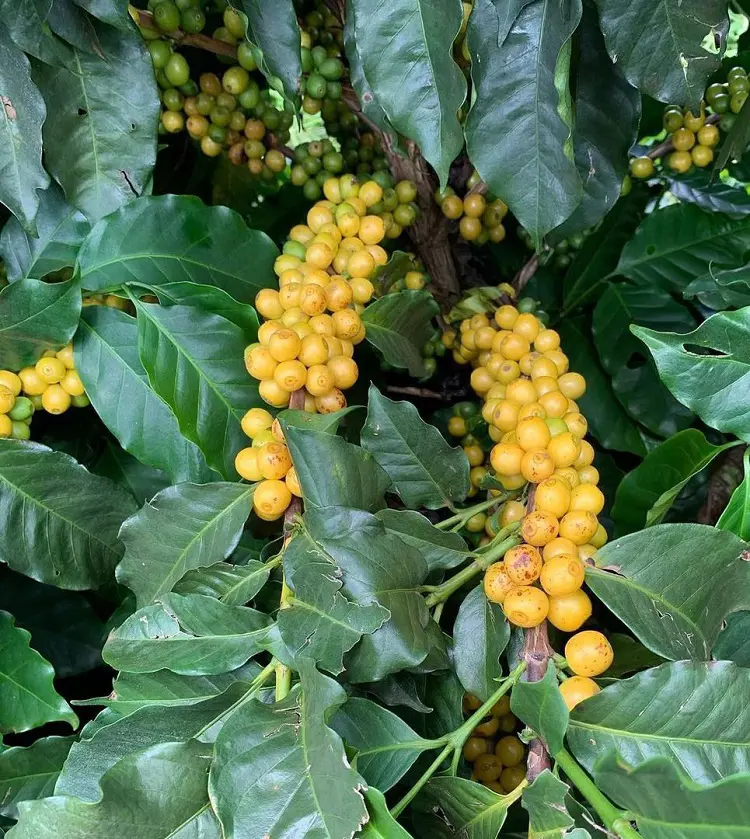
Several types of coffee plants are cultivated globally, each belonging to different species or varieties. The two main species are Arabica (Coffea arabica) and Robusta (Coffea canephora), and within these species, there are various cultivars. Here are a few notable types:
1. Arabica Coffee (Coffea arabica)
- Flavor Profile: Arabica is known for its mild and nuanced flavors with a range of aromatic notes, often featuring acidity and sweetness.
- Growing Conditions: It thrives at higher altitudes in cooler temperatures, typically between 2,000 to 6,000 feet.
2. Robusta Coffee (Coffea canephora)
- Flavor Profile: Robusta tends to have a stronger, more bitter taste with a full-bodied, earthy flavor.
- Growing Conditions: Robusta is hardier and can thrive at lower altitudes with higher temperatures compared to Arabica.
3. Typica
- Flavor Profile: Typica is known for its balanced, mild flavor profile, often featuring a slightly acidic and aromatic cup.
- Growing Conditions: It is well-suited to higher altitudes.
4. Bourbon
- Flavor Profile: Bourbon varieties often have a bright acidity, a full body, and a sweet, fruity complexity.
- Growing Conditions: It is commonly grown at higher elevations.
5. Geisha (or Gesha)
- Flavor Profile: Geisha is renowned for its exceptional flavor profile, often described as floral, tea-like, and with citrus notes.
- Growing Conditions: It is often cultivated at higher altitudes.
6. SL28 and SL34
- Origin: Developed in Kenya.
- Flavor Profile: Known for their distinct and complex flavor profiles, often exhibiting fruity and wine-like characteristics.
7. Ethiopian Heirloom
- Origin: Native to Ethiopia.
- Flavor Profile: Diverse flavors, ranging from fruity and floral to wine-like and spicy.
8. Pacamara
- Hybrid: A cross between Pacas and Maragogipe varieties.
- Flavor Profile: Pacamara often produces a cup with a rich, full body and vibrant acidity.
Problem While Growing Coffee Plant
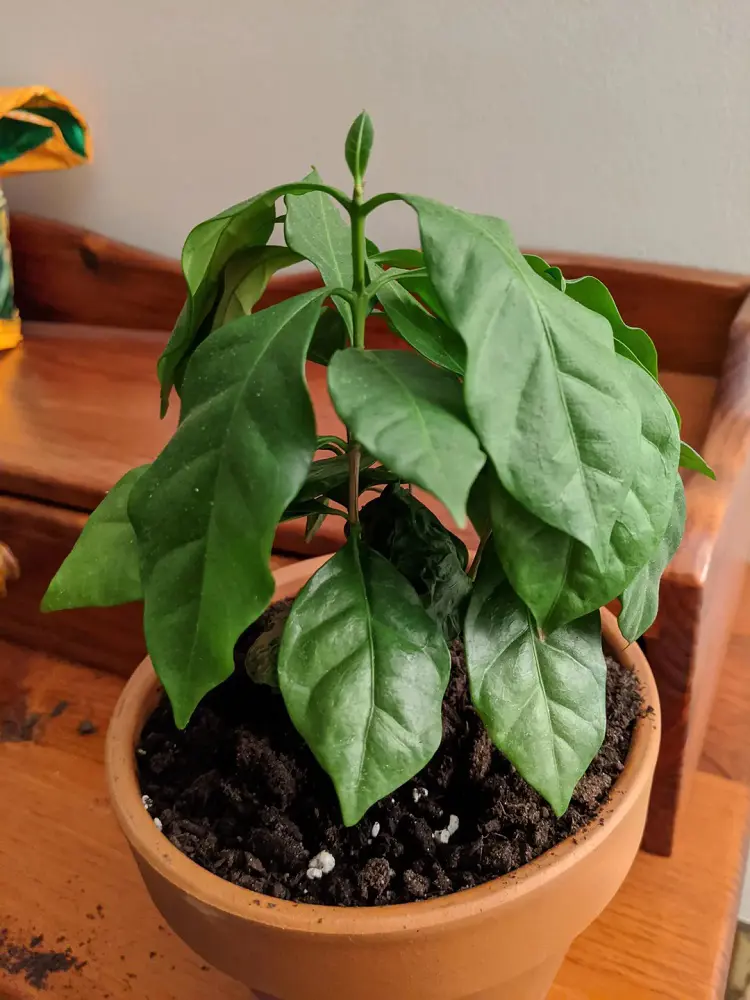
Growing coffee plants can be a rewarding but challenging endeavor. Here are some common problems that coffee plant growers may encounter:
Overwatering or Underwatering
- Problem: Inconsistent watering, either too much or too little, can lead to root rot or dehydration.
- Solution: Maintain a regular watering schedule, allowing the top inch of soil to dry out between watering. Use well-draining soil.
Nutrient Deficiency
- Problem: Yellowing leaves may indicate a nutrient deficiency, especially if the plant lacks essential minerals like nitrogen, potassium, or magnesium.
- Solution: Feed the plant with a balanced, water-soluble fertilizer formulated for acid-loving plants.
Pests
- Problem: Infestation by coffee berry borers, aphids, or mealybugs.
- Solution: Implement integrated pest management, use beneficial insects, and apply organic controls like neem oil.
Disease
- Problem: Coffee plants can be susceptible to fungal diseases like rust or bacterial infections.
- Solution: Use disease-resistant coffee varieties, maintain good air circulation, and avoid overwatering.
Transplant Shock
- Problem: Repotting or transplanting can cause stress to the plant, leading to wilting or leaf drop.
- Solution: Minimize root disturbance during transplanting, water adequately, and provide a recovery period in a shaded area.
Inadequate Pollination (for those growing for coffee beans)
- Problem: If coffee is for beans, inadequate pollination may result in poor fruit development.
- Solution: If growing indoors, consider hand-pollination or ensure proper conditions for natural pollination if growing outdoors.
Recent posts
Plant Care
Plant Care
10 Calendula Health Benefits and Possible Side Effects
[image-1] Commonly used in medicinal preparations in several medicine systems, calendula is an annual herb in the daisy family (Asteraceae) originating from southern Europe and the Eastern Mediterranean area. It is suitable for borders, beds cut flow...
Plant Care
How To Plant, Grow and Care Majesty Palm
The majestic palm, scientifically known as Ravenea rivularis, makes for a stunning indoor tree with its lush and grand fronds. Originating from Madagascar's river banks, this resilient houseplant is cherished not only for its beauty but also for its ...



